On January 13, 2010, the cover page of “24 hours”, a supplement of Yedioth Achronot, featured four dozen historical black-and-white photos of underage survivors of the Holocaust holding a sign with their name in the camera. The pictures were taken after World War II in Kloster (monastery) Indersdorf in Bavaria to give assistance to the search for family members. In 2010 the historic photographs were published in an Israeli newspaper to find these survivors in Israel.
In 2019 the pictures are part of the photo exhibition „HaChaim SheAchare“ (The Life After), which opened on January 20 in the foyer of Tel Aviv University Central Library.
The exhibition is about the International and the Jewish Children’s Centers in Kloster Indersdorf, documenting two different historical humanitarian to help the youngest victims of Nazi Germany by creating a therapeutic enviroment which enabled them to forge a “life after” despite their traumatic past. The curator of the exhibition is Anna Andlauer, author of the book „The Rage To Live“ and the person behind the search for the survivors in 2010.
In her speech at the opening ceremony of the exhibition Anna Andlauer addressed details of the biographies of some of the survivors that she could track down and meet and talk to in the last few years.
The book “The Rage to Live” addresses the almost unregarded topic of underage survivors of the Holocaust who had experienced unimaginable horror and after their liberation had to become aware of the loss of their families. For the Allied troops, the military administration and the aid organizations, they presented an unprecedented challenge. In the DP Children’s Center Indersdorf, the UNRRA team 182 around Greta Fischer tried to help the children to process their traumatic experiences and provide them with strength for their future life. Kloster Indersdorf was the first DP Children’s Center in the US occupied zone. It was established in June 1945 and relocated to Prien in the summer of 1946. From July 1946 to September 1948 a Hebrew Children’s Home („Beit HaYeladim HaIwrit“) was run in the monastery Indersdorf by the Zionist-Socialist youth movement Dror to practicaly and ideologicaly prepare underage survivors for a future life in a kibbutz in Erez Israel.
Anna Andlauer took an interest in the topic only when she discovered the diary of Greta Fischer at the Holocaust Memorial Museum in Washington. Greta Fischer, who had studied trauma therapy at Anna Freud, had to flee from the Nazis as a Jew herself. In her notes, Greta Fischer mentions the irrepressible will to survive, that she noticed in Indersdorf. Anna Andlauer therefore gave her book the title “The Rage to Live”.
Present at the opening ceremony were the German Ambassador to Israel, the President of the University of Tel Aviv and the district administrator of the Dachau district. At the ceremony a short film with historical recordings from the monastery Indersdorf was presented to the many visitors that filled the lobby of the TAU library. Among more than a hundred visitors was also a delegation of visitors from the Dachau district. As guests of honor, more than a dozen Holocaust survivors, who were in the monastery Indersdorf after the war, were present with their families.
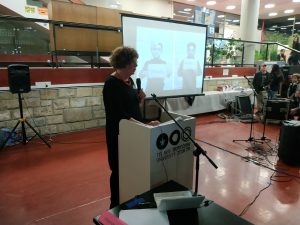
Among them Shmuel Reinstein, who was born on April 24, 1930 as the eighth child of Jewish traders in Strzemieszyce. In his home in Givatayim a few days before the opening ceremony of the exhibition he talked about his childhood. In young years he experienced the German occupation and the constant intensification of the repression against the Jews and finally the ghetto and the deportations. When the Germans and the Polish auxiliary police installed by the Germans carried out an Aktion in the ghetto, Shmuel saw his mother for the last time. He himself managed to escape from the selection area to his grandmother’s house, which was right next to it. There he was tracked down with dogs. In 1992, Shmuel took his children to Strzemieszyce to show them the house and the staircase he had been trying to hide under. Anna Andlauer recalled in her speech that Shmuel Reinstein had then succeeded in sneaking from the side of the condemned to the workable, where his brother Meir threw a coat over him, so he would not be discovered. In a following selection, the 11 ½ year Shmuel claimed that he was 17 years old and a plumber.
The ones capable of work were brought to Auschwitz, where they were tattooed with a number and told that from then on they would have no names but only numbers. Like his brother Meir, Shmuel was sent to the labor camp Blechhammer. The day in Blechhammer began with the appeal from four to quarter to seven. Then the SS picked up the forced laborers. Once when Shmuel was scheduled to knock stones and did not do that to the satisfaction of the warden, he was hit so hard with the rifle butt that he collapsed bleeding. From Blechhammer Shmuel and his brother Meir were deported to Gros Rosen and from there to Buchenwald. In Buchenwald they arrived at the clothes of political prisoners. From Buchenwald they were brought to Flossenbürg. In the main camp Flossenbürg, that was overcrowded with about 15,000 prisoners at that time, Shmuel and his brother were squeezed with about 2,000 Poles and Ukrainians in a barrack. When Shmuel told his story he remembered Flossenbürg as a „very dreadful place“. After pausing and staring into the empty he says: „There was a lot, that is too brutal to be told“
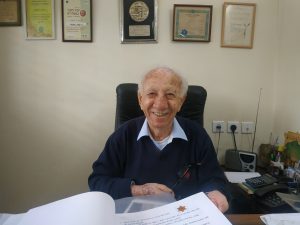
When the Americans conquered Bavaria, the prisoners from Flossenbürg were sent on various evacuation marches towards Dachau. The death marches pulled a trail of blood. In thin prisoner clothing and with wooden shoes in the cold and in the pouring rain through fields and swampy meadows, it was not possible for many prisoners to keep up. Whoever fell back was shot mercilessly. Shmuel tells how they were driven through villages where the population saw the emaciated prisoners. Quite frequently people were killed before the eyes of villagers. Shmuel walked in the front rows to risk here and there picking some food from the roadside without being left behind. When they heard tanks at Regensburg and SS men deserted, they knew that their rescue was near.
Via Regensburg the brothers reached Neunburg, where Meir, who had typhoid fever, was treated. In Neunburg, Shmuel made contact with GIs who listened to his story and were appalled. Shmuel explained to the Americans stationed in Neunburg how they could identify SS people due to their tattoos. A colonel in the US Army wrote a letter for Shmuel stating that every American is required to help him. When his American friends were transferred to Japan, Shmuel wanted to join them, but was told that it was too dangerous. Greta Fischer, a UNRRA employee, later discovered the Reinstein brothers on the street and brought them to the DP child center monastery Indersdorf. In that time they became Zionists. The Americans offered Shmuel to go to the US, but Shmuel dreamed of living in a Yishuv in Palestine.
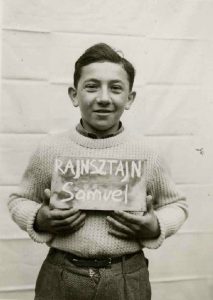
In a speech he made at the UN headquarters in New York on January 26, 2016, Shmuel thanked the US and the US Army for his release and for providing him with clothing and food in Neunburg. Furthermore, he thanked Greta Fischer and the UN team in the monastery Indersdorf, who gave him „food on a plate with a knife and a fork, a bed with white covers and cushions and a toothbrush“. Shmuel told the UN that Indersdorf was like a home where he felt reborn. Shmuel gave the speech on the occasion of the opening of the exhibition „Life after Survival“ in the lobby of the United Nations. It is the same exhibition currently on display in Tel Aviv.
Another survivor who attended the opening ceremony of “The Life After” in the TAU is Zalman Ackermann, who was a Madrich (guide) of Dror in the Hebrew Children’s Home in Kloster Indersdorf.
In Kfar Saba, where Zalman Ackermann lives today, he tells days before the opening of the exhibition of the brutal bombardment of Warsaw by the German Air Force and the German occupation of Warsaw. Zalman recalls the inhumane narrowness in the Warsaw ghetto, hunger and starvation, the illnesses that many people fell victim to, and the shootings. Zalman also remembers the frozen bodies who lined the streets of the ghetto in the winter of 1941. At the beginning of 1942, Zalman’s father was picked up on the street and taken away. Zalman was left with only his mother. Then came the big Aktion in the summer of 1942. Zalman remembers how Germans roared in the yards: „Alle raus! Alle runter!“. Even today, Zalman says, these cries immediately come to mind when he hears German. Zalman, who had already fallen into the hands of the Germans, was able to escape during a brief mass panic from the deportation site, instinctively and with the will to survive.
On April 19, 1943 Zalman witnessed the outbreak of the uprising in the Warsaw ghetto. He and his mother sat in an underground bunker that they could only leave at night, as the Germans retreated at night for fear of the Jewish insurgents. Zalman was recruited by the resistance as a messenger. Finally he had to watch as the Germans burned down quarter by quarter, street by street and house after house. When Zalman and his mother were discovered by the Germans, it was a moment of fear and horror. They were sure they would be executed immediately but, they were taken to a deportation train with many other Jews found in the ghetto. Zalman decided to jump off the train on the ride. As the most traumatic moment in the war, Zalman describes the decision to separate himself from his mother. Zalman survived the jump and went back to Warsaw. There he got arrested and taken to the Paviak prison of the SD and was deported from there to Majdanek. In contrast to hundreds of thousands who were gassed in Majdanek, Zalman came to the labor camp Skarzeco Kamienna and from there in the end of 1944 to a branch of the camp in the city Czestochowa. In January 1945 he was deported to the Buchenwald concentration camp. The last station of the hell he had to go through until his liberation by the Americans was the death march.
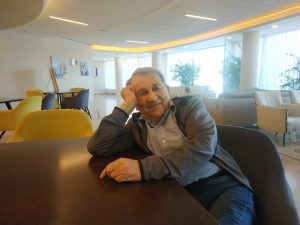
In an American DP camp Zalman was treated and recovered against all odds. Driven by the desire to find family members, he went to Warsaw but had to find out that nobody of his family had survived the Holocaust except of him. Zalman told the many visitors of the opening ceremony of the exhibition that the Jewish Council of Warsaw sent him to the Dror center, where he met Zivia Lubetkin. Coming from a familiy of Bundists he found it strange to see young Zionists dancing the Hora in the Dror center but as he said he liked the girls and stayed. Zalam was sent by Zivia Lubetkin to the Dror Kibbutz in Sosnowiec and from there to a six-week Madrich seminar in Lodz. At the seminar Zalman was taught socialism, Zionism and „Palestinografia“ and became a convinced Zionist. From a kibbutz in Bielawa the Madrich Zalman got to the Beit HaYeladim HaIwrit in Indersdorf. „It is important that you understand that it was anything but obvious that I became a Madrich after I got to Warsaw without family and without any belongings except the cloths I wore“.
One of the temporary members of „Beit HaYeladim HaIwrit“ was Dr. Nachum Bogner, who came to the exhibition opening with his wife. Few days before the ceremony in his home in kibbutz HaLamed Hey he talked about his way via Indersdorf to Israel began in 1944 in Galicia in a Soviet institution for war orphans in Lvov. Nachum had survived the war as the only child of a group of 40 Jews hiding in the woods. His father and his mother, who belonged to the group, which at first counted 150 Jews, did not survive the time in the forest. In the Soviet orphanage, despite the turmoil of the ongoing war, he was well looked after, but at school he and other Jews were confronted with anti-Semitism, which they believed had disappeared. He and other Jewish children and adolescents demanded that the director of the orphanage send them to Poland. When asked what they wanted there, they said, „Go on to Palestine.“ In Poland, Nachum went to Krakow, where he turned to the Jewish Council, which sent him to a children’s house in Rabka-Zdroj and from there to Zakopane, where Lena Kichler ran a children’s house. Since Lena Kichler herself was a Zionist, she supported the desire of several children of her institution, to get to Palestine. To make it happen she met with Zivia Lubetkin in Lodz. That’s how in January 1946 Nachum got to the first children kibbuz of the Dror movement in Byton, where at the time about 100 12-18 -year-old Jewish survivors of the Holocaust were accommodated.
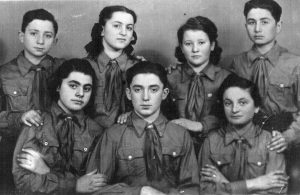
In Bytom, the will of Nachum to emigrate to Palestine solidified. Nachum was in a ten-member group, whose eldest was just 15 years old, that the Bricha sent from Byton to Bratislava in March 1946 and from there via Pocking to the Dror kibbutz in Landsberg. Nachum emphasizes in an conversation in the kibbutz HaLamed Hey that he never had a penny in his pocket on his flight. When, after the pogrom of Kielce, 20,000 Jews moved from the east to the west , the Zionist youth movements searched for opportunities to absorb the refugees. Dror founded the Hebrew Children’s Home in Indersdorf where Nachum became part of the Polish group that due to the influx of Jews from Poland grew to more han 200 members.
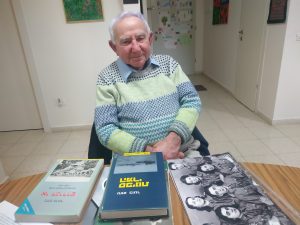
Informal leader of the Beit HaYeladim HaIwrit was the emissary of the Yishuv, Shulamit Katz, who named the Polish group „Eitan“. One of the Madrichim who assisted her was Zalman Ackermann. Dr. Nachum Bogner testified to Anna Andlauer that Zalman with his exemplary behavior was the ideal Madrich.
In Israel the Eitan group of which a part was on the „Exodus“ founded kibbutz HaLamed Hey. The day after the opening of the exhibition „The Life After“, Anna Andlauer and the delegation from Dachau visited HaLamed Hey and planted a tree.
The exhibition „The Life After“ will open on January 20th and will be on display until February 28th at the TAU, Sourasky Central Library. In March, April and May the exhibition will be in the Yad Tabenkin Documentary Center in Ramat Efal. There Dr. Nachum Bogner will speak on he 2nd. of April about children in the Bricha. In June the exhibition will be on display in the Mediterranean Towers in Kfar Saba and in July and August in the Cultural Center in Petach Tikva. In January 2020 the Israel tour of the exhibition will end in the Hadassah hospital in Jerusalem to mark Greta Fischers 110th birthday.